Languages without Bilabial Consonants
DOI:
https://doi.org/10.13135/2384-8987/5820Abstract
The existence of consonants at the velar, alveolar and bilabial places of articulation seems to represent the basis of the structure of a consonant system, described by many authors according to various approaches. Nevertheless a few scattered references to languages without any bilabial sound can be found in literature, especially by authors dealing with American native languages. For this reason, the presence of bilabial consonants cannot be considered as a universal of language but rather a linguistic tendency, admitting, as such, some exceptions. The above mentioned references describe the phenomenon by a merely synchronic perspective, leaving thereby aside, not only extinct languages, but also those showing at a distant time in the past the lack of these sounds, which were later introduced in their consonant inventory.
This article provides first of all a mapping of all languages and linguistic families involved, regardless whether they are living, extinct or characterized by this phenomenon at a distant time in the past. Further, it yields a description of how the phenomenon occurs, based on the analysis of the different languages and linguistic families involved, along with a research on the explication of the possible reasons underlying it.
Downloads
Published
How to Cite
Issue
Section
License
RiCognizioni is published under a Creative Commons Attribution 4.0 International License.
With the licence CC-BY, authors retain the copyright, allowing anyone to download, reuse, re-print, modify, distribute and/or copy their contribution. The work must be properly attributed to its author.
It is not necessary to ask further permissions both to author or journal board.








